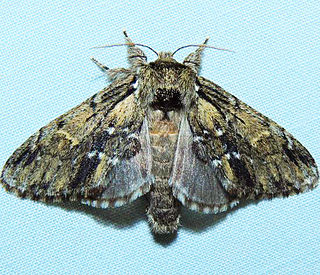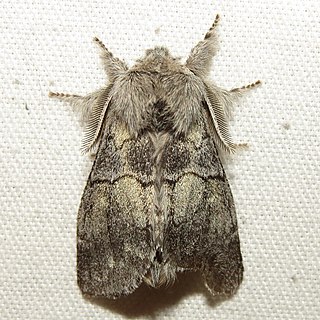Gluphisia wrightii is a species of moth in the family Notodontidae. It was first described by Henry Edwards in 1886 and it is found in North America.
Acronicta dolli, or Doll's dagger moth, is a species of moth in the family Noctuidae. It was first described by William Barnes and James Halliday McDunnough in 1818 and it is found in North America.

Eudocima serpentifera is a species of fruit-piercing moth in the family Erebidae first described by Francis Walker in 1858. It is found in North America.
Afilia oslari is a species of moth in the family Notodontidae. It was first described by Harrison Gray Dyar Jr. in 1904 and it is found in North America.
Symmerista zacualpana is a species of moth in the family Notodontidae. It was first described by Max Wilhelm Karl Draudt in 1932 and it is found in North America.
Dichagyris kyune is a species of cutworm or dart moth in the family Noctuidae. It was first described by William Barnes in 1904 and it is found in North America.
Dichagyris lobato is a species of cutworm or dart moth in the family Noctuidae. It was first described by William Barnes in 1904 and it is found in North America.

Heterocampa biundata, the wavy-lined heterocampa, is a species of moth in the family Notodontidae. It was first described by Francis Walker in 1855 and it is found in North America.

Clostera brucei, the Bruce's prominent moth or Bruce's chocolate-tip, is a species of moth in the family Notodontidae. It was first described by Henry Edwards in 1885 and it is found in North America.
Dichagyris socorro is a species of cutworm or dart moth in the family Noctuidae. It was first described by William Barnes in 1904 and it is found in North America.
Dasychira dorsipennata, the sharp-lined tussock or hardwood tussock moth, is a species of tussock moth in the family Erebidae. It was first described by William Barnes and James Halliday McDunnough in 1919 and it is found in North America.
Heterocampa zayasi, the blue moor-grass moth or zaya heterocampa, is a species of moth in the family Notodontidae. It was first described by Torre and Alayo in 1959 and it is found in Cuba.
Cucullia strigata, the streaked hooded owlet or streaky falconer, is a species of moth in the family Noctuidae. It was first described by Smith in 1892 and it is found in North America.
Tarache bella is a species of bird-dropping moth in the family Noctuidae first described by William Barnes and Foster Hendrickson Benjamin in 1922. It is found in North America.
Sympistis deceptiva is a species of moth in the family Noctuidae. It was first described by William Barnes and Arthur Ward Lindsey in 1922 and it is found in North America.

Hyperaeschra georgica, the Georgian prominent, is a species of moth in the family Notodontidae. It was first described by Gottlieb August Wilhelm Herrich-Schäffer in 1855 and it is found in North America and parts of Australia.

Gluphisia lintneri, the Lintner's gluphisia moth or Lintner's pebble, is a species of moth in the family Notodontidae. It was first described by Augustus Radcliffe Grote in 1877 and it is found in North America.
Tripudia damozela is a species of moth in the family Noctuidae. It was first described by Harrison Gray Dyar Jr. in 1914 and it is found in Central and North America.
Oslaria pura is a species of moth in the family Noctuidae. It was first described by William Barnes and James Halliday McDunnough in 1911 and it is found in North America.

Gluphisia avimacula, the four-spotted gluphisium or avimacula pebble, is a species of moth in the family Notodontidae. It was first described by George H. Hudson in 1891 and it is found in North America.






